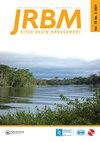印度查谟克什米尔-喜马拉雅上杰勒姆盆地饮用水源质量评价
IF 1.9
Q3 WATER RESOURCES
International Journal of River Basin Management
Pub Date : 2022-02-04
DOI:10.1080/15715124.2022.2036747
引用次数: 3
摘要
水是地球上所有生物最重要的自然资源。水的质量被认为是与包括人类在内的生物的健康和疾病状况有关的主要因素。本研究旨在评价克什米尔喜马拉雅山脉上Jhelum盆地的水质。采用了多级采样技术。为了达到水质评估的测量值,从不同的饮用水源共采集了60个水样。采用适当的统计技术和相关的水质评价方法对数据进行分析。这些结果与世界卫生组织(WHO)和印度标准局(BIS)的标准规范进行了比较。结果表明,除编码为RWS1、RWS4、RWS5、RWS6、RWS13和RWS14的采样点水质较差外,大部分采样点水质为优或良。调查结果显示,水质波动是由人为活动造成的,如家庭废物、农业和园艺活动,以及自然过程,如风化和侵蚀。总的来说,推论统计显示,水质从优良到中度污染不等。因此,必须保证水体的适当净化和及时监测。这项研究的目的是建议补救措施,以减轻情况的恶化和未来的相关影响。本文章由计算机程序翻译,如有差异,请以英文原文为准。
Quality assessment of drinking water sources in the upper Jhelum basin of Kashmir Himalaya, J&K, India
ABSTRACT Water is the most significant natural resource for all living beings on the planet. The quality of water is considered the main factor linked to the status of health and disease in living organisms, including humans. The present study aims to assess the quality of water in the upper Jhelum basin of the Kashmir Himalayas. A multi-stage sampling technique has been used. To achieve the measured values for quality assessment, a total of 60 water samples were collected from various drinking water sources. The data was analyzed using suitable statistical techniques and relevant methods of water quality assessment. The results were compared with standard norms of the World Health Organization (WHO) and the Bureau of Indian Standards (BIS). The inferences revealed that most of the sampling sites had either excellent or good water quality, except for the sites encoded as RWS1, RWS4, RWS5, RWS6, RWS13 and RWS14, which depicted poor water quality. The findings revealed that water quality fluctuations are caused by anthropogenic activities such as domestic waste, agriculture and horticulture, as well as natural processes such as weathering and erosion. In general, the inferential statistics revealed that water quality varies from excellent to moderately polluted. Thus, proper purification and timely monitoring of water bodies must be ensured. The purpose of the study is to suggest remedial measures to ease the deterioration and related repercussions in the future.
求助全文
通过发布文献求助,成功后即可免费获取论文全文。
去求助
来源期刊

International Journal of River Basin Management
WATER RESOURCES-
CiteScore
6.00
自引率
4.00%
发文量
48
期刊介绍:
include, but are not limited to new developments or applications in the following areas: AREAS OF INTEREST - integrated water resources management - watershed land use planning and management - spatial planning and management of floodplains - flood forecasting and flood risk management - drought forecasting and drought management - floodplain, river and estuarine restoration - climate change impact prediction and planning of remedial measures - management of mountain rivers - water quality management including non point source pollution - operation strategies for engineered river systems - maintenance strategies for river systems and for structures - project-affected-people and stakeholder participation - conservation of natural and cultural heritage
 求助内容:
求助内容: 应助结果提醒方式:
应助结果提醒方式:


